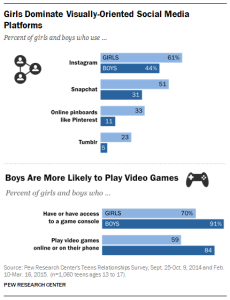New Study on Teens, Social Media & Technology from Pew
A new study was released on April 9, 2015, from Pew Research Center on how teens, ages 13-17, use social media and technology. The center collected data from 1,060 teens from September 25 to October 9, 2014 and February 10 to March 16, 2015.
Since its release, one of the most pulled statistics has been that
“24% of teens go online ‘almost constantly,’ facilitated by the widespread availability of smartphones.” However, there are other interesting findings to be had in the report.
For example, how does family income affect the choice of which social network a teen chooses to use? In addition, how has the availability of smartphones affected the modes of communication teens choose?
Smartphone Availability is the Cornerstone of Teens’ Online and Social Media Activities
The availability of smartphones has led to 92% of teens being online daily. Of those 92% of teens, 24% are online “almost constantly,” 56% report being online several times each day and 12% use the Internet once a day.
Pew’s survey also showed that 91% of teens are using a mobile device to access the Internet. According to the study, almost three-fourths of all teens own, or have access to, a smartphone. Only 12% of teens don’t have a cell phone of any kind.

In addition to granting access to the online world, having access to a smartphone has shifted the ways in which teens are communicating with each other. 90% of teens that have access to mobile phones text, and send a median of 30 texts per day. 73% are using messaging apps like WhatsApp or Kik, with African-American and Hispanic teens more likely than white teens to be using the app(s).
Which Social Media Networks Teens Are Using
While many teens have been leaving the platform, Facebook remains the most popular social site with 71% of teens using it. Instagram (51%) and Snapchat (41%) round out the top three platforms. More interestingly, 71% of teens surveyed stated that they are using more than one social network.
Pew also found in its research that 22% of teens only use one social platform. The 22% further breaks down into the sole platforms:
- 66% only use Facebook
- 13% only use Google+
- 13% only use Instagram
- 3% only use Snapchat
While Facebook continually drives organizations toward advertising to reach their audience on its platform, Facebook will remain a good place for brands to target their younger audiences for the time being.
Social Media Usage by Gender
Demographically, there are some interesting splits between which social networks teen boys and girls are more likely to visit. Generally, girls tend to use the more visual platforms than their male counterparts.
Just over one-in-five teens use online pinboards, like Pinterest. The demographics teens using of sites like Pinterest break into:
- 22% of teens use Online Pinboards:
- 33% of teen girls
- 11% of teen boys
The other sites frequented by teens:
- 71% of teens use Facebook:
- 70% of teen girls
- 72% of teen boys
- 33% of teens use Twitter:
- 37% girls
- 30% boys
- 33% of teens use Google+:
- 33% girls
- 33% boys
- 52% of teens use Instagram:
- 61% teen girls
- 44% teen boys
- 41% of teens use Snapchat:
- 51% girls
- 31% boys
- 24% of teens use Vine:
- 27% girls
- 20% boys
- 14% of teens use Tumblr:
- 23% girls
- 5% boys
The study also found that teen boys are far more likely to play video games than girls. Whether it was playing games online, on their phones, or through a console, boys vastly outweigh girls for interacting through gaming.
Household Income’s Effect on Social Media Use
The socio-economic status of the teens in the survey seemed to make a difference in which social media platform(s) they chose to participate. Teens from households that make less than $50,000 annually are much more likely to report that they use Facebook most often. From the study’s data there seems to be much more diversification of social media networks the more affluent the home the teenager is from. One of the more interesting findings through the income perspective is the amount of friend overlap on a teen’s many social channels. The key takeaways from Pew’s observations in this are:
- Teens from households earning $50,000+ per year are “substantially more likely to report some overlap” of friends.
- Multi-platform teens that come from households earning less than $75,000 annually are more likely to report having the same friends across their channels.
- Teens with annual household incomes of less than $50,000 are more likely to state that their friends are “completely compartmentalized” on their various social media channels.
Implications of the Research
Teens and young adults have always been a key target for businesses and knowing where, and how, to communicate is instrumental to reaching these tech savvy teens.
Not only does the access to technology change the way in which teenagers are interacting and communicating with each other, but it also changes how teens are finding information. In fact, TIME Magazine recently ran a story about how teenagers are utilizing the geo-tags from Instagram posts around college campuses that they are vetting in order to get an idea of what student life on campus is really like.
For years, marketers have been told that social media, and the Internet as a whole, is becoming more and more visual. This statement is only reinforced by the rise in the use of platforms like Instagram and Snapchat, as well as the implementation of capturing and editing video messages on Twitter earlier this year.
Sources:
Pew Research Center Internet, Science & Tech – Teens, Social Media & Technology Overview 2015
Cover Photo Credit:
“Texting, texting, texting…” by Tammy McGary Flickr Creative Commons


